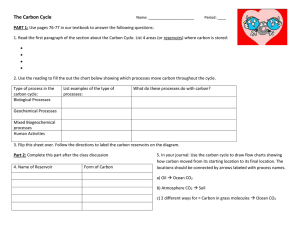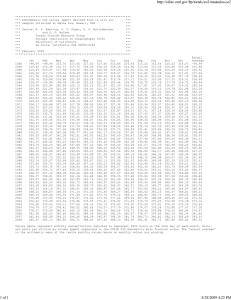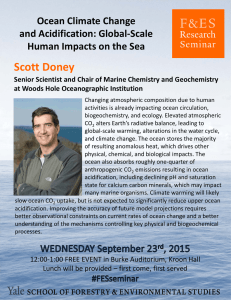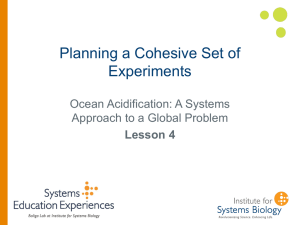12.842 / 12.301 Past and Present Climate �� MIT OpenCourseWare Fall 2008
advertisement
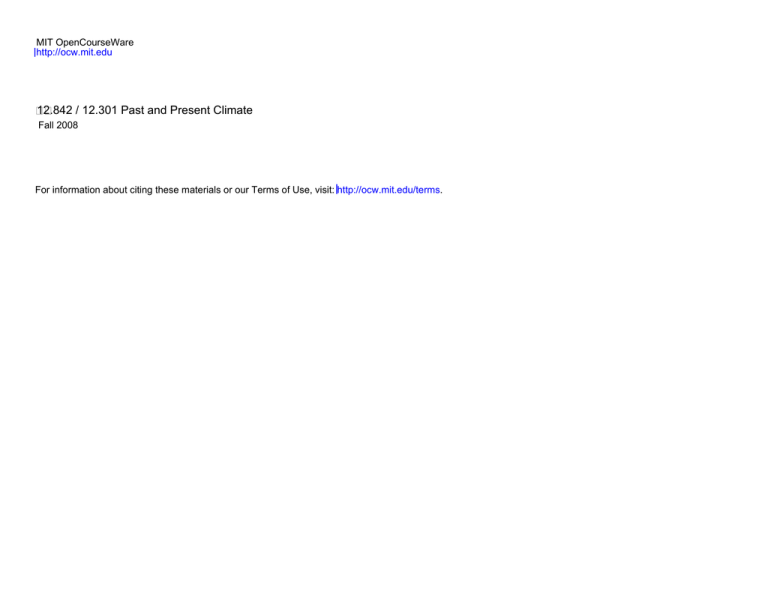
MIT OpenCourseWare http://ocw.mit.edu 12.842 / 12.301 Past and Present Climate �� Fall 2008 For information about citing these materials or our Terms of Use, visit: http://ocw.mit.edu/terms. 12.842 Climate Physics and Chemistry Fall 2008 Changes in CO2 during the past million years Gases in Ice Cores • Bubbles seal off at the bottom of the firn layer, ~80 120 m • Hence gas is younger than the solid ice that contains it - the “gas age/ice age difference” depends on the accumulation rate • Most gases are well mixed in atmosphere; so records from Antarctic and Greenland are nearly the same; features of the records can be used to correlate chronologies between hemispheres • Gases that have been measured: – CO2 – O2 (18O/16O ratio) – CH4 – N2O Recall: Ice core evidence for changes in atmospheric CO2 • Pre-anthropogenic pCO2 was about 280 ppmV • Glacial pCO2 was about 190 ppmV. Six Antarctic ice cores give same number. Vostok !D, CO 2 0-420 kyr (Petit et al., 1999) -300 300 250 p C O2 -350 200 -400 !D, ‰SMOW 150 -450 100 -500 50 0 100000 200000 300000 400000 Ice Age est. yrBP Data from Petit et al (1999) Nature, 419:188-190 Image removed due to copyright restrictions. δ18O and CH4 in Greenland and Antarctica Ahn & Brook (2008) Byrd CO2 1 Image removed due to copyright restrictions. Ahn and Brook (2008) Science 322:83. Figure 1. Ahn & Brook (2008) Byrd CO2 2 Image removed due to copyright restrictions. Ahn and Brook (2008) Science 322:83. Figure 2. Some Concepts to Explain Glacial- Interglacial CO2 cycles Role of Temperature in G/IG CO2 cycles • CO2 is more soluble in cold water than in warm water - so if the ocean temperature cools during ice ages, atm. CO2 should be lower because more ends up in the ocean. • Given an estimate of ocean surface temperatures, we can readily calculate how much more CO2 ends up in the ocean. • Although our knowledge of ocean surface temperatures during the Last Glacial Maximum (LGM) is imperfect, we can make a reasonable estimate: – -5°C in low-latitude ocean (probably an extreme possibility) – -2.5 in high-latitude ocean (can’t get any colder than the freezing point) • This would lead to a -30 ppmV drop in atmospheric CO2. • This is significant but only ~ 30% of the total. And.. Factors offsetting the decrease due to cooler temperatures: • The withdrawal of seawater into continental glaciers leave the ocean saltiers, and CO2 is less soluble in saltier waters (approximate magnitude: +6.5 ppmV) • The glaciers and cooler climate also reduced the continental biomass putting more carbon in the ocean, and thereby increasing atmospheric CO2. Carbon isotope observations imply a whole-ocean δ13C decrease of -0.35 ‰ during the LGM (presumed due to the oxidation and solubilization of the biomass) which would lead initially to a +15 ppmV increase in CO2. • After taking all of these things into account, the decrease in atmospheric CO2 due to all of these easy-to-estimate factors is 8.5 ppmV. • We are a long way from accounting for glacial CO2! Simple two-box ocean model atmosphere warm surface ocean P=0 ~ ~ ~ particle flux ~ ~ cold deep ocean Q P=2.2 CO2=2260 Alk=2375 seafloor Broecker’s 2-box interglacial ocean: Broecker’s 2-box glacial ocean: (Assumes that marine organic matter from continental shelf is oxidized and put into ocean and that sedimentary CaCO3 dissolves to keep [CO3=] of deep ocean approximately constant) Broecker’s interglacial/glacial oceans: Interglacial Glacial (Assumes that marine organic matter from continental shelf is oxidized and put into ocean and that sedimentary CaCO3 dissolves to keep [CO3=] of deep ocean is approximately constant) Toggweiler-Sarmiento (1984) 3-box model for interglacial / glacial CO2 see also: Knox and McElroy, Wenk and Siegenthaler Pre-Industrial Simulation Atmosphere 13 � C = -6.18 14 � C = +1 to -5 PCO = 271.2 2 Low latitude Box AOU = 0* PO4 = .2* ALK = 2277 �CO2 = 1932 �13C = 2.64 �14C = -54 PCO = 271.9 2 PCO = 269.0 2 10 19 1 19 45-60 0.90 0 to 1.0 High latitude Box AOU = 30* PO4 = 1.42 ALK =2338 �CO2 =2139 �13C=1.72 �14C=-100 to -112 Deep Box AOU = 1.54* PO4 = 2.15 ALK = 2374 �CO2 = 2256 �13C = .66 �14C = -159 Ice Age Simulation Atmosphere PCO = 213.0 2 Low latitude Box AOU = 0* PO4 = .2* ALK = 2454 �CO2 = 2029 �13C = 2.64 �14C = 25 PCO = 219.0 2 12 13 � C = -6.10 14 � C = 106 10 PCO = 193.9 2 1 12 9.5 0.55 0.5o High latitude Box AOU = 30* PO4 = .65 ALK = 2477 �CO2 = 2193 �13C = 2.30 �14C = -4 Deep Box AOU = 298 PO4 = 2.23 ALK = 2556 �CO2 = 2445 �13C =.12 �14C = -178 Steady state concentrations of model variables in the ocean and atmospheric boxes for the preindustrial and ice age simulations. Units are micromoles per kilogram for AOU, PO4, and �CO2; microequivalents per kilogram for alkalinity, parts per million for PCO2; and parts per thousand (per mil) for �13C and �14C. Model transports between boxes are given in units of sverdrups (106m3/s). Particle fluxes are given next to the wiggly arrows in units of moles C per square meter per year. Asterisks indicate values that are initial assumptions. Figure by MIT OpenCourseWare. This model suggests that the pre-formed nutrient content of polar surface waters decreases during glacial period (often pointing to increased high-latitude stratification as the mechanism for achieving higher nutrient utilization. An alternative proposal for the mechanism of nutrient depletion is the “Martin Hypothesis” that says that Fe limits Antarctic productivity and that this limitation is diminished during glacial periods by a higher dust flux to polar regions (see ice core data). The nitrogen fixation / inventory hypothesis (McElroy, Broecker, others…) • This hypothesis assumes that N is the limiting nutrient (instead of P). In other words, that the C:N ratio is fixed but the C:P ratio is flexible. • The residence time of NO3- in the ocean is on the order of thousands of years. If something perturbs the input/output balance, the nitrate concentration can respond relatively quickly. • Things that could perturb the nitrate balance: • More dust, more N fixation (until oxygen loss increases denitrification) • Changes in ocean circulation that diminish the low-O2 zones (inferred from δ15N W. N. Pacific and Arabian Sea - possibly but not necessarily related to ocean nutrient deepening) • Otherwise works the same as the “shelf phosphorus” model. Some Reading Broecker W. S. (1982) Ocean chemistry during glacial time. Geochim. Cosmochim. Acta 46, 1689-1705. Sigman, D. and E. Boyle (2000) Glacial/Interglacial variations in atmospheric carbon dioxide, Nature 407:859-869. Sarmiento, J.L. and R. Toggweiler (1984) A new model for the role of the oceans in determining atmospheric pCO2, Nature 308:621-624.
